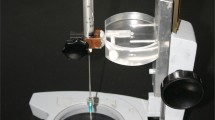Summary
Measurements of foliage quality, physiological, and phenological condition of sample trees were used as independent variables in multiple correlation analyses to determine their effect on female and male spruce budworm larval dry weights. Female budworm from trees high in foliar concentrations of beta-pinene, myrcene and total nitrogen weighed less than those from trees lacking these characteristics. Male budworm from trees high in foliar concentrations of alpha-pinene, myrcene, terpinolene, citronellyl acetate, and bornyl acetate weighted less than those from trees lacking these characteristics. Additionally, relatively vigorous and productive trees tended to be less susceptible (as evidenced by reduced larval weight) to budworm of either sex.
Similar content being viewed by others
References
Bate-Smith EC (1973) Haemanalysis of tannis: The concept of relative astringency. Phytochemistry 12:907–912
Berryman AA (1972) Resistance of conifers to invasian by bark beetle-fungus associations. BioScience 22:598–602
Blais JR (1957) Some relationships of the spruce budworm, Choristoneura fumiferana (Clem) to black spruce Picea marina (Moench) Voss. Forest Chron 33:364–372
Cates RG, Alexander HJ (1982) Host resistance and suseptibility. In: Mitton J, Sturgeon K (eds) Bark Beetles in North American Confifers: Ecology and Evolution. University of Texas Press, Austin, TX, pp 212–263
Cates RG, Redak RA, Henderson CB (1983a) Patterns in defensive natural product chemistry within and among populations of Douglas-fir affecting western spruce budworm success. In: Hedin PA (ed) Plant Resistance to Insects, American Chemical Society Symposium Series 208. American Chemical Society, Washington DC, pp 3–20
Cates RG, Redak RA, Henderson CB (1983b) Natural product defensive chemistry of Douglas-fir, western spruce budworm success, and forest management practices. Ziet ang Entomol 96:173–182
Chapman RE (1971) The Insects: Structure and Function, 2nd edition. Elsevier North Holland, Inc. New York
Feeny P (1970) Seasonal changes in oak leaf tannins and nutrients as a cause of spring feeding by winter moth caterpillars. Ecology 51:565–581
Feeny P (1976) Plant apparency and chemical defense. In: Wallace JW, Mansell RL (eds) Biochemical Interactions Between Plants and Insects. Recent Advances in Phytochemistry. v. 10. Plenum Press, New York, pp 1–40
Gosz JR (1981) Nitrogen cycling in coniferous ecosystems. In: Clark FE, Rosswall T (eds) Terrestrial Nitrogen Cycles, Ecological Bulletin. v. 33. Processes, Ecosystem Strategies, and Management Impacts. Swedish Natural Science Research Council, Stockholm, Sweden, pp 405–426
Johnson P, Denton R (1975) Outbreaks of the Western Spruce budworm in the American Northern Rocky Mountain Area from 1922 through 1971. US For Ser Gen Tech Rep INT-20. Ogden, Utah
Mattson WJ (1981) Heribivory in relation to plant nitrogen content. Ann Rev Ecol Systs 11:119–161
McNeil S, Southwood TRE (1978) The role of nitrogen in the development of insect/plant relationships. In: Harborne JB (ed) Biochemical Aspects of Plant and Animal Coevolution. Academic Press, New York, pp 77–98
Miller HG, Cooper JM, Cooper JD, Pauline OJL (1979) Nutrient cycles in pine and their adaptation to poor soils. Can J For Res 9:19–26
Mott DG (1963) The forest and the spruce budworm. In: Morris RF (ed) The Dynamics of Epidemic Spruce Budworm Populations, Memoirs of the Entomological Society of Canada No 31. Entomological Society of Canada. Ottawa, pp 189–202
Raffa KF, Berryman AA (1983) The role of host plant resistance in the colonization behavior and ecology of bark beetles (Coleoptera:Scolytidae). Ecol Monogr 53:27–49
Redak RA (1982) A determination of the resistance-susceptibility characteristics in Douglas-fir to the western spruce budworm. MS thesis, University of New Mexico, Albuquerque, New Mexico
Rhoades DF (1979) Evolution of plant chemical defense against herbivores. In: Rosenthal GA, Janzen DH (eds) Herbivores: Their Interaction with Secondary Plant Metabolites. Academic Press New York, pp 4–54
Rhoades DF, Cates RG (1976) A general theory of plant antiherbivore chemistry. In: Wallace JW, Mansell RL (eds) Biochemical Interaction Between Plants and Insects. Recent Advances in Phytochemistry. v 10. Plenum Press, New York, pp 168–213
Rosenthal GA, Janzen DH (1979) Herbivores: Their Interaction with Secondary Plant Metabolites. Academic Press, New York
Saunier RE, Hull HM, Ehrenreich JH (1968) Aspects of the drought tolerance in creosotebush (Larrea divaricata). Plant Physiol 43:401–404
Scriber JM (1977) Limiting effects of low leaf water content on the nitrogen utilization, energy budget, and larval growth of Hyalophora cecropia (Lepidoptera:Saturniidae). Oecologia (Berlin) 28:269–287
Scriber JM, Slansky F (1981) The nutritional ecology of immature insects. Ann Rev Ecol Syst 26:183–211
Van den Driessche R, Dangerfield J (1975) Response of Douglas-fir seedlings to nitrate and ammonium nitrogen sources under various environmental conditions. Plant and Soil 42:685–702
Van den Driessche R, Weber JE (1975) Total and soluble nitrogen in Douglas-fir in relation to plant nitrogen status. Can J For Res 5:580–585
White TCR (1969) An index to measure weather induced stress of trees associated with outbreaks of Psyllids in Australia. Ecology 50:905–909
White TCR (1974) A hypothesis to explain outbreaks of looper caterpillars, with special reference to populations of Selidosema suavis in a population of Pinus radiata in New Zealand. Oecologia (Berlin). 16:279–301
Zar JH (1974) Biostatistical Analysis. Prentice-Hall, Inc. Englewood Cliffs, New Jersey
Zucker WV (1983) Tannis: Does structure determine function? An ecological perspective. Am Nat 12:335–365
Author information
Authors and Affiliations
Rights and permissions
About this article
Cite this article
Redak, R.A., Cates, R.G. Douglas-fir (Pseudotsuga menziesii)—spruce budworm (Choristoneura occidentalis) interactions: the effect of nutrition, chemical defenses, tissue phenology, and tree physical parameters on budworm success. Oecologia 62, 61–67 (1984). https://doi.org/10.1007/BF00377374
Received:
Issue Date:
DOI: https://doi.org/10.1007/BF00377374




